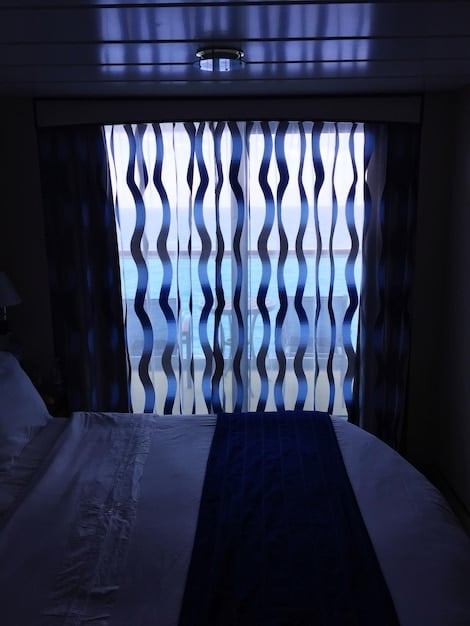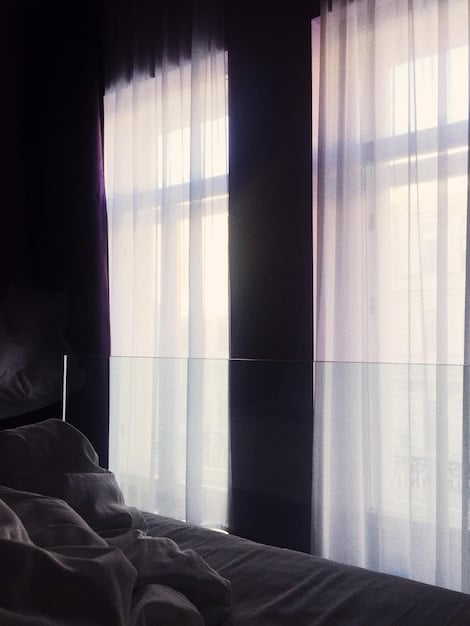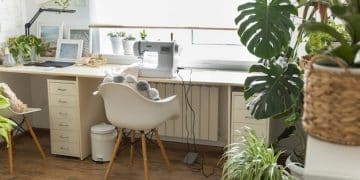Sleep Better Tonight: Expert Tips for Your 2025 Sleep Environment

Optimizing your sleep environment is crucial for achieving restful sleep; this article delves into expert tips for 2025, covering elements like lighting, temperature, noise, and technology to enhance your sleep quality.
Want to sleep better tonight: expert tips for optimizing your sleep environment in 2025 can help, but where do you even begin? Creating the perfect sleep sanctuary is more than just having a comfy bed – it’s about mastering all the elements that contribute to a restful night.
Understanding the Importance of a Sleep-Optimized Environment
Creating an ideal sleep environment is not merely a luxury; it’s a necessity for overall health and well-being. Your surroundings significantly impact your ability to fall asleep, stay asleep, and achieve restorative rest. By optimizing your sleep environment, you address potential sleep disruptors and enhance your natural sleep patterns.
The Science Behind Sleep Environment
Scientific research demonstrates a clear link between environmental factors and sleep quality. Elements like light, temperature, and noise directly influence the production of melatonin, a hormone crucial for regulating sleep. Disruptions in these factors can lead to fragmented sleep, insomnia, and other sleep disorders.
- Light Exposure: Light suppresses melatonin production, making darkness essential for sleep. Blue light from screens can be particularly disruptive.
- Temperature Regulation: A slightly cooler environment promotes better sleep by aligning with the body’s natural temperature drop during sleep.
- Noise Control: Loud or inconsistent noises trigger arousal responses, disrupting sleep cycles and making it harder to fall back asleep.
Optimizing your sleep environment mitigates these disruptions, allowing your body to relax and transition into deep, restorative sleep. This results in improved cognitive function, mood regulation, and physical health.
Controlling Light: Blackout Curtains and Smart Lighting
Light is a powerful regulator of our circadian rhythm, the internal clock that governs sleep-wake cycles. Managing light exposure, especially in the evening and during sleep, is crucial for improving sleep quality.

The Power of Blackout Curtains
Blackout curtains are an effective way to block out external light sources such as streetlights, car headlights, and early morning sunlight. These curtains create a dark environment conducive to sleep, promoting melatonin production and preventing sleep disturbances.
- Material Selection: Choose curtains made from thick, tightly woven fabrics that effectively block light.
- Proper Installation: Ensure the curtains completely cover the window and minimize gaps around the edges.
- Layering Options: Combine blackout curtains with sheer curtains for daytime light control and privacy.
Smart Lighting Solutions for Better Sleep
Smart lighting systems offer customizable light settings that can mimic natural light patterns and optimize your sleep environment. These systems allow you to adjust the color temperature and brightness of your lights, promoting relaxation and preparing your body for sleep.
By using smart lighting, you can create a sleep-friendly atmosphere that supports healthy sleep habits and enhances your overall well-being.
Optimizing Temperature: The Ideal Sleep Temperature
Temperature plays a critical role in regulating sleep. The body’s core temperature naturally decreases as it prepares for sleep, and maintaining a cool sleep environment supports this process. Experts recommend a bedroom temperature between 60 to 67 degrees Fahrenheit (15.5 to 19.4 degrees Celsius) for optimal sleep.
Strategies for Cooling Down Your Bedroom
Achieving the ideal sleep temperature often requires adjustments to your bedroom setup and habits. Here are some effective strategies for cooling down your sleep environment:
- Adjust Your Thermostat: Lower your thermostat a few hours before bedtime to allow your bedroom to gradually cool down.
- Use Fans: Utilize fans to circulate air and create a cooling breeze. Ceiling fans, floor fans, or even personal fans can be effective.
- Choose Breathable Bedding: Opt for bedding made from natural, breathable materials like cotton, linen, or bamboo. These fabrics help wick away moisture and keep you cool throughout the night.
The Benefits of a Cool Sleep Environment
Sleeping in a cool room offers numerous benefits beyond just comfort. It can improve sleep quality, regulate metabolism, and even reduce the risk of certain health conditions. A cooler sleep environment can also deepen REM sleep, which is crucial for cognitive function and memory consolidation.

By prioritizing temperature control in your sleep environment, you enhance your ability to fall asleep quickly, stay asleep longer, and wake up feeling refreshed and rejuvenated. Maintaining the ideal temperature is an essential component of a comprehensive sleep optimization strategy.
Managing Noise: Soundproofing and White Noise Machines
Noise pollution is a prevalent issue that can significantly disrupt sleep. Unwanted sounds, whether from traffic, neighbors, or internal household activities, can interfere with your ability to fall asleep and stay asleep. Effective noise management is essential for creating a peaceful and restorative sleep environment.
Strategies for Soundproofing Your Bedroom
Soundproofing your bedroom involves making physical modifications to reduce the amount of noise that enters the space. Here are some practical strategies to consider:
The Role of White Noise Machines
White noise machines generate consistent, ambient sounds that mask distracting noises and promote relaxation. These machines produce a range of frequencies that help to smooth out the soundscape, making it easier to fall asleep and stay asleep. White noise can also be helpful for individuals with tinnitus or other auditory sensitivities.
- Soundproofing Windows: Install double-paned windows or use soundproof curtains to block external noise.
- Sealing Gaps and Cracks: Seal any gaps or cracks around doors, windows, and walls to prevent sound from entering.
- Adding Sound-Absorbing Materials: Incorporate sound-absorbing materials such as acoustic panels, thick rugs, and upholstered furniture to reduce echo and reverberation within the room.
Tech and Sleep: Balancing Gadgets and Rest
In today’s digital age, technology is deeply integrated into our lives. However, the use of electronic devices before bed can have detrimental effects on sleep. The blue light emitted from screens suppresses melatonin production, disrupting the natural sleep-wake cycle. Balancing the convenience of technology with the need for restful sleep requires mindful habits and strategic tools.
Implementing a Digital Curfew
One of the most effective ways to mitigate the negative effects of technology on sleep is to establish a digital curfew. This involves setting a specific time each evening when you power down electronic devices and engage in relaxing, screen-free activities. The digital curfew allows your brain to unwind and prepare for sleep without the stimulative effects of blue light and digital content.
- Set a Specific Time: Define a time each evening when you will power down all electronic devices, ideally one to two hours before bedtime.
- Create a Pre-Sleep Routine: Replace screen time with relaxing activities such as reading a book, listening to calming music, or practicing meditation.
- Charge Devices Outside the Bedroom: Keep electronic devices out of the bedroom to eliminate the temptation to use them before bed.
By implementing a digital curfew, you create a clear boundary between technology use and sleep, promoting healthier sleep habits and improving overall sleep quality.
Leveraging Sleep Tech Responsibly
While excessive tech use before bed is detrimental, certain sleep-related technologies can be beneficial when used responsibly. Sleep trackers, smart alarms, and sleep apps can provide valuable insights into your sleep patterns and help you optimize your sleep environment.
- Sleep Trackers: Use sleep trackers to monitor your sleep stages, heart rate, and movement throughout the night. Analyze the data to identify patterns and potential sleep disruptors.
- Smart Alarms: Utilize smart alarms that wake you up during your lightest sleep phase, minimizing grogginess and promoting a more natural and gentle awakening.
- Sleep Apps: Explore sleep apps that offer guided meditations, white noise sounds, and personalized sleep recommendations.
The Role of Bedding: Comfort and Support
The quality of your bedding significantly impacts your sleep comfort and overall sleep quality. Choosing the right mattress, pillows, and sheets can make a substantial difference in your ability to fall asleep quickly, stay asleep longer, and wake up feeling refreshed.
Selecting the Perfect Mattress
Your mattress is the foundation of your sleep environment. An ideal mattress should provide adequate support for your spine, distribute your weight evenly, and minimize pressure points.
- Consider Your Sleep Position: Side sleepers may prefer softer mattresses that conform to the body, while back and stomach sleepers may benefit from firmer mattresses that provide better support.
- Evaluate Material Options: Explore different mattress materials such as memory foam, latex, innerspring, and hybrid mattresses. Each material offers unique benefits in terms of comfort, support, and temperature regulation.
- Test Before You Buy: Visit a mattress store and try out different mattresses to find one that suits your individual preferences and needs.
By selecting the right mattress, you invest in a comfortable and supportive sleep surface that promotes proper spinal alignment and reduces discomfort, enhancing your overall sleep experience.
Choosing the Right Pillows and Sheets
In addition to a good mattress, the right pillows and sheets can further enhance your sleep comfort. Pillows should provide proper neck and head support, while sheets should be soft, breathable, and comfortable against your skin.
- Pillow Selection: Choose pillows that align your neck and spine in a neutral position. Consider different pillow fills such as down, feathers, memory foam, and latex.
- Sheet Material: Opt for sheets made from natural, breathable materials such as cotton, linen, or bamboo. These fabrics help regulate temperature and wick away moisture, keeping you comfortable throughout the night.
- Thread Count: Pay attention to thread count, which indicates the density of the fabric. Higher thread count sheets are generally softer and more durable.
Creating a comfortable and supportive bedding setup contributes to a restful and rejuvenating sleep experience. By carefully selecting your mattress, pillows, and sheets, you optimize your sleep environment and enhance your overall well-being.
| Key Point | Brief Description |
|---|---|
| 🌙 Darken Room | Use blackout curtains to block external light and enhance melatonin production. |
| 🌡️ Cool Temp | Maintain a bedroom temperature between 60-67°F (15.5-19.4°C) for optimal sleep. |
| 🔇 Reduce Noise | Use soundproofing techniques or a white noise machine to minimize sleep disruptions. |
| 📱 Digital Curfew | Establish a digital curfew 1-2 hours before bed to reduce blue light exposure. |
Frequently Asked Questions
▼
The ideal temperature for sleep is between 60 to 67 degrees Fahrenheit (15.5 to 19.4 degrees Celsius). This cooler temperature helps facilitate the body’s natural temperature decrease, promoting better sleep.
▼
Blackout curtains block external light, which can disrupt melatonin production. By creating a dark environment, they help regulate the sleep-wake cycle and improve sleep quality.
▼
Yes, white noise machines can be effective for sleep. They mask distracting sounds, create a consistent auditory environment, and promote relaxation, making it easier to fall and stay asleep.
▼
Blue light emitted from electronic devices suppresses melatonin production, a hormone essential for sleep. This disruption can make it harder to fall asleep and reduce the quality of your sleep.
▼
Bedding made from natural, breathable materials like cotton, linen, or bamboo is often best for sleep. These fabrics help regulate temperature and wick away moisture, ensuring a comfortable sleep environment.
Conclusion
Optimizing your sleep environment involves addressing various factors, from light and temperature to noise and technology usage. By implementing these expert tips, you can create a sleep sanctuary that promotes restful and rejuvenating sleep, enhancing your overall health and well-being. Prioritize these adjustments to sleep better tonight: expert tips for optimizing your sleep environment in 2025 can help you achieve the sleep you deserve.





